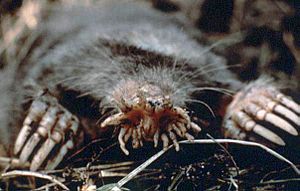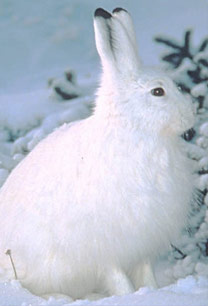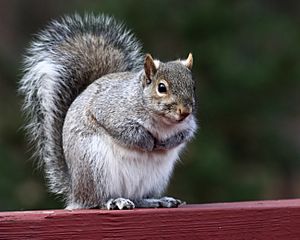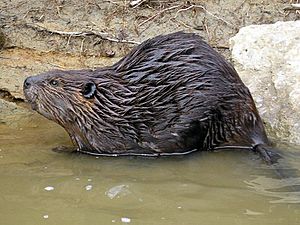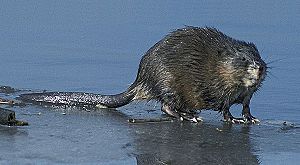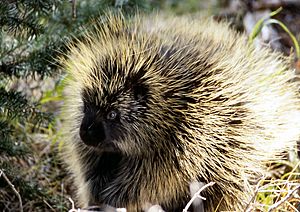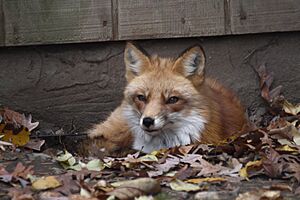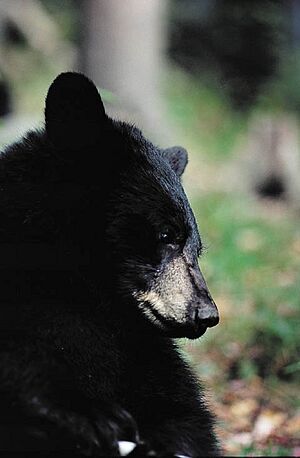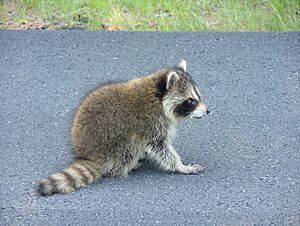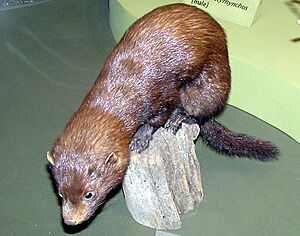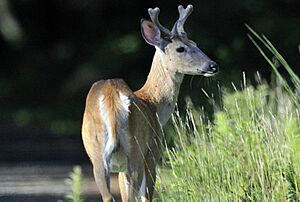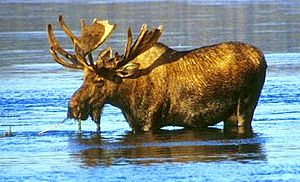List of mammals of Connecticut facts for kids
Connecticut is home to many amazing mammals! This list tells you about the wild mammals that live here now, or used to live here. It includes both animals that naturally live in Connecticut (native species) and those that came from other places (nonnative species). We won't be talking about farm animals or pets here.
Many mammals that once disappeared from Connecticut have come back. Sometimes, people helped them return with special projects. Other times, they just naturally moved back from nearby states as Connecticut's environment became more welcoming.
Hundreds of years ago, when European settlers first arrived, many mammal species were hunted a lot. Forests were also cut down to create farmland. This meant animals like moose, black bears, and mountain lions lost their homes and their numbers dropped a lot, or they disappeared completely from the state. Pollution in the 1800s and 1900s also harmed some animals, like the bald eagle.
Later, in the 1800s and 1900s, farming became less common in Connecticut. Because of this, forests started to grow back over much of the land. These new forests aren't exactly the same as the old ones. For example, chestnut trees, which were a big food source for many animals, are now rare because of a disease. But new things like old stone walls, built by farmers, now provide cozy homes for some species. Also, new animals like the house mouse and Norway rat from Europe, and the coyote from other parts of North America, have changed the environment. They compete with some native animals, but also provide new food sources for others, like the barn owl.
In recent years, new homes and buildings have caused some forests to be cut down or broken into smaller pieces. However, some good changes have happened too. Certain polluting industries have left Connecticut, and sewage treatment plants have gotten better. Still, some pollution remains, and winds often bring pollution from the New York City area to Connecticut. The state also creates some of its own pollution.
One common way people in Connecticut see wild mammals is when animals are hit by cars on roads. The animals most often seen as roadkill are striped skunks, opossums, raccoons, and gray squirrels.
Contents
Species
Opossums
- Virginia opossum (Didelphis virginiana) — These animals are common in wooded areas, farmlands, and even in some towns. They came to Connecticut from the south in the early 1900s. They probably spread because they are attracted to human food sources like crops and trash. Opossums eat almost anything, including dead animals. Many opossums are hit by cars on Connecticut roads.
Shrews and moles
Shrews (Order Eulipotyphla, Family Soricidae)
- Northern short-tailed shrew (Blarina brevicauda) — Very common in leafy or grassy areas, usually in forests.
- Smoky shrew (Sorex fumeus) — Common, especially in moist, shady places.
- Masked shrew (Sorex cinereus) — Plentiful in the state, especially in moist, shady spots.
- Water shrew (Sorex palustris) — Not common; found near water.
- Least shrew (Cryptotis parva) — Rare in Connecticut. This is the edge of their natural range. In Connecticut, they are only found in coastal areas with tall beach dunes and nearby salty marshes. All other shrews in the state have much longer tails. As of 2007, the least shrew was the only mammal on Connecticut's endangered species list. The biggest danger to them is coastal development, which takes away their land and separates groups of them. Pesticides and pollution also threaten their food and homes. This animal was first found in Darien in 1840, but wasn't seen again for 100 years!
Moles (Order Eulipotyphla, Family Talpidae)
- Eastern mole (Scalopus aquaticus) — Common in the state. Usually found in fields, lawns, and wooded areas that aren't too wet. They are less common in higher, northern parts of the state.
- Star-nosed mole (Condylura cristata) — Common in wet or moist soils near water. Less common in moist areas on higher ground.
- Hairy-tailed mole (Parascalops breweri) — Somewhat common in well-drained areas in the northwestern part of the state.
Bats
Bats (Order Chiroptera, Family Vespertilionidae)
Connecticut has eight types of bats that still live here, plus at least one that may have disappeared.
Some bats can carry rabies. The state's Department of Energy and Environmental Protection (DEEP) advises:
- "If a bat has bitten or scratched a person or a pet, or is found in a situation where exposure cannot be ruled out, contact the DEP Wildlife Division at (860) 424-3011 or DEP Emergency Dispatch at (860) 424-3333 for advice."
- This includes when a bat is found in the same room as someone sleeping or a very young child.
Bats that live in buildings
- Little brown bat (Myotis lucifugus) — Common and found all over the state. This and the big brown bat are the two most common bat species in Connecticut.
- Big brown bat (Eptesicus fuscus) — Spends winters in the state, often sleeping in buildings, sometimes in caves. If you see a bat in winter, it's probably this species. In summer, they often rest in attics. They have babies in the state.
Bats that rest in trees in summer
- Silver-haired bat (Lasionycteris noctivagans) — Not common; usually seen near water. It's listed as a Connecticut species of special concern.
- Red bat (Lasiurus borealis) — Usually found in lower areas. Seldom seen and listed as a Connecticut species of special concern.
- Hoary bat (Lasiurus cinereus) — Seldom seen and listed as a Connecticut species of special concern.
- Northern long-eared myotis or long-eared bat (Myotis septentrionalis)
Bats that sleep in caves and tunnels
- Northern long-eared myotis (see above)
- Little brown bat (see above)
- Eastern small-footed bat (Myotis leibii) — Thought to have disappeared from the state, and it was probably always rare. No confirmed sightings have been recorded in Connecticut for many years. It's listed by the state as a "species of special concern."
- Indiana bat (Myotis sodalis) — In many decades leading up to 2004, only one was ever found in the state. This bat is on both state and federal endangered species lists.
- Tricolored bat (Perimyotis subflavus or Pipistrellus subflavus)
Rabbits and hares
Rabbits and hares (Order Lagomorpha, Family Leporidae)
- Eastern cottontail (Sylvilagus floridanus) — This species was brought to New England in the late 1800s. It has spread, often taking over areas where the native New England cottontail used to live. It originally came from the south. You can find them in shrubby and open areas, often where the land has been changed by humans. Hammonasset Beach State Park has many of them.
- New England cottontail (Sylvilagus transitionalis) — This rabbit is native to Connecticut but is now less common because the eastern cottontail has largely replaced it. It seems to be more common in the west-central and southeastern parts of the state. They usually live in shrubby wetlands and forests with thick plants close to the ground.
- Snowshoe hare (Lepus americanus) — Common in the northern part of the state, usually where there are thick bushes.
Rodents
Squirrel family (Order Rodentia, Family Sciuridae)
- Groundhog, woodchuck or whistle pig (Marmota monax) — They were rare when Europeans first came to North America, but their numbers have grown since then.
- Eastern gray squirrel (Sciurus carolinensis) — This is the mammal you'll see most often in Connecticut, and it's the largest squirrel in the state. The amount of acorns (their food) can change a lot each year, which affects how many squirrels there are. Sometimes, large groups of squirrels migrate. In Stratford, white squirrels (a local type of gray squirrel) have been seen for years. Many of them have some light gray or reddish color and black eyes, meaning they are not albinos.
- Fox squirrel (Sciurus niger) - This squirrel no longer lives in Connecticut.
- American red squirrel (Tamiasciurus hudsonicus) — Usually found where there are many mature pine or hemlock trees.
- Northern flying squirrel (Glaucomys sabrinus) — Found in only a few areas in northern Connecticut, usually in old forests.
- Southern flying squirrel (Glaucomys volans) — Common where there are nut trees and places to nest, often near streams and wetlands.
- Eastern chipmunk (Tamias striatus) — Common in woods.
Beavers (Order Rodentia, Family Castoridae)
- North American beaver (Castor canadensis) — Found in small and large streams, lakes, and other deep water that doesn't freeze completely in winter. They are most common where their favorite food plants grow, like aspen and willow. Beavers not only build dams on smaller streams but can also be found in rivers too big to be dammed. They were common in Connecticut before Europeans arrived, but trapping caused them to disappear by about 1842. They were brought back, starting in Union in 1914. They did so well that in 1961, the state started allowing trapping again to control their numbers because of complaints. The population is now large enough that generally 500 to 1,000 are trapped each year. In 2000, it was estimated there were between 5,000 and 8,000 beavers in the state. They can bother homeowners by cutting down trees and causing floods with their dams. In Connecticut, people need a permit from their town to change beaver dams to prevent flooding.
Mice, rats, voles, lemmings (Order Rodentia, Family Muridae)
- White-footed mouse (Peromyscus leucopus) — Common in woods and especially along forest edges, particularly where there are many nuts or large seeds.
- Eastern deer mouse (Peromyscus maniculatus) — Found in the northern part of the state.
- Allegheny woodrat (Neotoma magister) — Once lived in one spot in western Connecticut but has now disappeared from the state.
- Southern red-backed vole (Clethrionomys gapperi) — Common in the state, especially in forests with lots of ground cover like logs, rocks, or old stone walls.
- Meadow vole (Microtus pennsylvanicus) — Often found in large numbers in pastures, meadows, marshes, or wherever there are thick, uncut grasses.
- Woodland vole (Microtus pinetorum) — Common in the state; found mostly in partly wooded uplands.
- Muskrat (Ondatra zibethicus) — Common in ponds, lakes, slow-moving streams, canals, swamps, and marshes.
- Southern bog lemming (Synaptomys cooperi) — Usually lives along the edges of bogs, but sometimes found in shady uplands with thick, rich soil.
- House mouse (Mus musculus) — Common in cities and on farms, usually found near people and farmland. It originally came from Europe.
- Norway rat (Rattus norvegicus) — Common wherever it can find food, like on farms, in cities, near garbage dumps, or by water. It also came from Europe. Barn owls near the New Haven landfill often eat them.
Jumping mice (Order Rodentia, Family Dipodidae, Subfamily Zapodinae)
- Meadow jumping mouse (Zapus hudsonius) — Quite common in Connecticut in areas with thick plants, including meadows, old fields, and forest edges, often near water.
- Woodland jumping mouse (Napaeozapus insignis) — Quite common in Connecticut in moist, forested areas or spots with thick bushes, usually along streams.
New World porcupines (Order Rodentia, Family Erethizontidae)
- North American porcupine (Erethizon dorsatum) — Not common in forested areas in the northern part of the state. Usually found in mixed forests that include eastern hemlock trees. Porcupines are most common in northern Litchfield County. It's not unusual to see them as roadkill along Route 8.
Carnivorans
Dogs, wolves, coyotes, and foxes
- Coyote (Canis latrans) — First seen in Connecticut in the mid-1950s. For the first 10 years, they were only reported in the northwestern part of the state, but they have since spread across the entire state. The state Department of Environmental Protection (DEEP) estimated there were 2,000 to 4,000 coyotes in the state as of 2007, and their numbers were growing.
- Gray wolf (Canis lupus) — This animal disappeared from Connecticut in the 1800s. Early settlers deliberately killed them, and their numbers also dropped because their main food source (deer) was reduced.
- Red fox (Vulpes vulpes) — This species is native to New England, but it probably mixed with red foxes brought from Europe. The type of red fox in Connecticut today is thought to be a mix. They tend to avoid areas where coyotes are common. They prefer habitats with a mix of fields and forest edges.
- Gray fox (Urocyon cinereoargenteus) — Fairly common, but less so than the red fox. It tends to live in denser forests than the red fox. Their numbers have been growing for the past century because forests have grown back in the state.
Bears
- Black bear (Ursus americanus) — Rare in most of the state, but fairly common in Litchfield and Hartford counties in the northwestern and north-central parts of the state. Bears have spread from their main home in the state's northwestern hills. They have been seen as far south as Greenwich. In 2008, state wildlife biologists estimated there were more than 300 bears in the state, and the population was growing by about 15 to 20 percent each year. They had disappeared from the state by 1840, but the DEEP found clear evidence of bears living here again in the 1980s. Since then, sightings have increased a lot. In 1997, the DEEP received about 100 calls about bears; in 2007, they received 2,000. The state DEEP encourages people to report bear sightings on their website. Forests growing back was the main reason bears could return and spread. The state usually doesn't remove bears unless they are in a city. Bears that keep killing farm animals, entering buildings, or causing other serious problems may be killed. There is no hunting season for bears in Connecticut. In 2023, a black bear famously stole 60 cupcakes from a bakery in Avon! The DEEP asks people who see bears to:
- "Enjoy it from a distance."
- "Never attempt to feed or attract bears."
- "Report bear sightings to the Wildlife Division, at (860) 675-8130."
Raccoons and relatives
- Raccoon (Procyon lotor) — Found near lakes, ponds, marshes, and streams. A rabies outbreak greatly reduced their numbers in the state in the early 1990s, killing as much as 75 percent of the population. Raccoon rabies is still present in Connecticut, with about 200 cases a year as of 2004. Rabies cases should be reported to police or animal control officials.
Weasels and otters
- River otter (Lontra canadensis) — Was rare before, but now somewhat common in the state. Found in many lakes and large ponds.
- American marten (Martes americana) — A recent road-kill in New Hartford was the first clear proof that this animal lives in Connecticut.
- American ermine (Mustela erminea) — Like the long-tailed weasel, fairly common in woods and thickets and near stone walls, especially near rivers and streams.
- Long-tailed weasel (Neogale frenata) — Like the ermine, fairly common in woods and thickets and near stone walls, especially near rivers and streams.
- Mink (Neogale vison) — Quite common in streams, ponds, lakes, and marshes.
- Fisher (Pekania pennanti) — Fishers live in large, thick forests. This species disappeared from southern New England when forests were cleared and was gone for over 100 years. From 1989 to 1991, they were brought back from New Hampshire. By 2004, they were living well in northern Connecticut.
Skunks
- Striped skunk (Mephitis mephitis) — Common in the state and found in many different habitats.
Cats
- Canada lynx (Lynx canadensis) — This animal probably never lived permanently in Connecticut, but it might have been here sometimes in the past. They are now considered to have disappeared from the state.
- Bobcat (Lynx rufus) — They prefer thick bushes and patchy woods in the least-developed areas of the state, especially in the northwest highlands. They are usually rare where coyotes are more common. Unlike coyotes, bobcats don't adapt well to living near people. They prefer young forests with thick plants close to the ground. In the 1970s, the price of bobcat fur went up so much that state officials worried too many would be hunted. They made the bobcat a protected animal, with no hunting or trapping seasons. In 2003, a bobcat with rabies attacked a man in Plainville, but this was a very rare event.
- Cougar (Puma concolor) — There is no strong proof that this animal lives in Connecticut, but it might be rare in hilly parts of northern Connecticut. Officially, they are considered to have disappeared from the state. However, a state DEEP official confirmed seeing a live cougar in Durham in October 2011. A cougar was also killed on the Wilbur Cross Parkway in Milford in June 2011.
Hoofed mammals
Deer (Order Artiodactyla, Family Cervidae)
White-tailed deer
- White-tailed deer (Odocoileus virginianus) — The number of deer in Connecticut is huge and still growing. This is largely because more rural areas are being developed for homes, which creates good habitats for deer but aren't suitable for hunting. Other reasons include a mix of young and old forests, milder winters, and fewer predators. Deer were almost gone from the state by the late 1800s, with fewer than 20 in all of Connecticut. But their numbers started to grow back, partly because of state rules to protect them. In 1974, the state passed its first deer management law, and regular, licensed deer hunting began the next year. By the 1970s, the total state population was about 20,000, and up to 76,000 (a low estimate) in 2000.
Fairfield County has the most deer per square mile in the state. According to one estimate, it has 59 deer per square mile, which is more than double the rest of the state. Deer can carry many ticks, and many of these ticks carry Lyme disease. The state allows bowhunting for deer from September 15 to January 31.
Connecticut has several problems because of its large deer population:
- Car accidents: State Farm insurance estimates that more than 10,000 deer in Connecticut are hit by cars each year. But the state DEEP estimates only 3,000 deer-car accidents happen annually.
- Lyme disease: When the deer population in Groton was reduced by about 90 percent, the number of new Lyme disease cases in town dropped from about twenty a year to two or three a year.
- Habitat damage: In Greenwich, the Audubon Society's 600-acre land has seen deer push out ground birds like the ovenbird. The deer have severely damaged plant species that were once common there.
Moose
- Moose (Alces alces) — Moose have become more common in Connecticut in recent years. The first time babies were officially seen was in 2000. As of 2007, there were an estimated 100 moose in the state. By 2015, the population could be over 200. Most of these moose now live in northern Litchfield County. They can sometimes be found throughout northern Litchfield and northwestern Hartford Counties and are known to wander throughout the state. When forests were largely replaced by farmland hundreds of years ago, moose (along with animals like turkeys, black bears, and mountain lions) lost their homes and disappeared from the state. But even before Connecticut was settled by Europeans, the moose population was never very large. Moose are thought to be entering the state from the north.
The biggest danger to people from moose is car collisions. From 1995 to 2006, there was an average of one car collision with a moose each year across the state. Unlike deer, moose that feel threatened tend to stand their ground. Local police can kill moose if they are a danger to public safety, which usually means the animal is too close to a highway. In 2007, police killed male moose in Waterbury and Fairfield when each moose came close to a highway. If there's no immediate danger, DEEP officials usually try to calm the animal with a tranquilizer dart or scare them into a nearby woods. In 2008, state authorities tranquilized a young female moose in New Britain and released it in a state forest in northern Connecticut. Moose are generally shy, but male moose tend to wander in the fall during mating season. Young moose also wander when their mothers are about to have new babies.
Elk
- Eastern elk (Cervus canadensis canadensis) — This type of elk is now extinct. Elk no longer live in Connecticut.
Mammals in Long Island Sound
Whales (Order Cetacea, Family Delphinidae)
- Long-finned pilot whale (Globicephala melas) — Occasionally enters Long Island Sound. It rarely washes up on the shore in Connecticut.
Porpoises (Order Cetacea, Family Phocoenidae)
- Harbor porpoise (Phocoena phocoena) — Rare, but sometimes found off the coast.
Seals (Order Carnivora, Family Phocidae)
- Harbor seal (Phoca vitulina) — This is the only marine mammal that regularly lives in Connecticut. Found mostly in the eastern part of the coast, but also in the west. Not uncommon around Hammonasset Beach State Park, and they have been seen off Stamford and Greenwich. They are found from late fall through mid-spring, usually on isolated rocks. In the past, they might have lived here all year, but seal hunters and fishermen probably stopped that. For the warmer months, they travel to the Maine coast.
- Gray seal (Halichoerus grypus) — Occasionally seen in Long Island Sound but usually lives farther north.
|
See also
- Fauna of Connecticut
- List of birds of Connecticut
- Flora of Connecticut
- Long Island Sound
- List of mammals of North America
- Mammals of New England
- Lists of mammals by region



